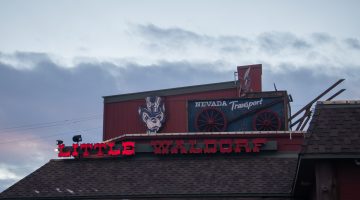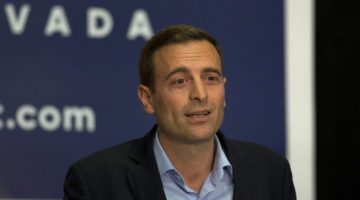
Jacob Solis/ The Nevada Sagebrush
Nevada Attorney General Adam Laxalt speaks to the press after a campaign announcement in Sparks on Wednesday, Nov. 1, 2017. Laxalt is the third Republican to jump in the race to replace termed-out Gov. Brian Sandoval.
To the surprise of few, Nevada Attorney General Adam Laxalt announced last Wednesday he would launch a bid for governor in a week-long, 17-county campaign tour that kicked off with events in Las Vegas and Sparks. At both events, he delivered a personal speech that focused as much on his personal struggles and family ties as it did on policy positions, and it seemed to immediately cement his position as a GOP frontrunner.
The announcement makes Laxalt the fifth hopeful to toss a hat in the gubernatorial ring, and the third Republican to do so far this year.
These five are all looking to replace a term-limited Gov. Brian Sandoval, a Republican, who is among the most popular governors in the country. Polling from Morning Consult puts Sandoval at sixth most popular nationwide, with an approval rating of 61 percent and disapproval of just 21 percent.
For the GOP, he joins state treasurer Dan Schwartz and activist and bike shop owner Jared Fisher. On the Democratic side, a battle of Clark County commissioners — commission chair Steve Sisolak and district E commissioner Chris Giunchigliani.
Perhaps predictably for a race that is still about a year away, there hasn’t been all that much campaigning done so far. Even so, that’s not to say campaigning has been non-existent, especially by some of the state’s more well-funded candidates.
Notably, there’s that statewide tour still being undertaken by Laxalt, in addition to a $1 million ad buy for Laxalt from the Freedom Partners Action Fund superPAC, a group with ties to the GOP mega-donor Koch Brothers.
That campaign money — from both inside and outside the state — tied with a family name that is perhaps more endemic to Nevada politics than any other, means that Laxalt is and likely will remain the favorite going into next summer’s Republican primary.
However, Laxalt’s stock in the Republican Party has yet to isolate him from occasional intra-party strife, most notably with the sitting Sandoval. Just last month, Sandoval took Laxalt to task at least twice for proposing to repeal the state’s commerce tax, a 2015 measure levied on businesses making more than $4 million per year.
For his part, Schwartz has yet to make much of a campaign splash since announcing his gubernatorial effort back in September, though he was quickly made the target of superPAC ads that took aim at his proposed “alternative” budget from 2015 — a budget that was shut down by legislative Republicans.
Things are similar for Fisher, who has been sticking to the grassroots since undertaking a statewide bike tour in April.
On the Democratic side, the establishment Sisolak will be the one running with the resources. State law allows candidates to carry over funding from previous campaigns, and it means Sisolak entered the race in June with a war chest nearing $4 million (for comparison, at the same time Laxalt had raised about $1.5 million).
However, in his time as commission chairman, Sisolak has made more than a few unpopular decision, including throwing his support behind a stadium deal designed to lure the Oakland Raiders to Las Vegas.
And while voters in Clark County are mixed on the stadium debate, a poll from January of this year found that Washoe County voters overwhelmingly opposed the stadium deal (and its accompanying room tax) with a margin of 71 percent opposed to just 19 percent for.
But even so, Sisolak’s challenger, Giunchigliani, will still be fighting an uphill battle, especially when it comes to fundraising and drumming up name recognition with Democrats outside of Clark County. She has signaled that her effort is a serious one, however, and has taken to hiring outside strategists to boost her campaign efforts.
Among those hires is her campaign manager, Eric Hyers, who helped boost Montana’s Democratic Gov. Steve Bullock to a reelection victory in 2016, despite Montana voters breaking for Donald Trump by about a 20 point margin.
Regardless of the nominee, this will be the first shot for Democrats to take back the governor’s mansion in 20 years since they lost it first to Republican Kenny Guinn in 1998. Guinn would serve two terms before being replaced in 2006 by Jim Gibbons, another Republican.
The next shot came in 2010, when Dems hoped to unseat a historically unpopular Gibbons whose approval ratings had plummeted to near single digits. Those hopes would be dashed, though, when Brian Sandoval left a seat on the federal bench to oust Gibbons as the GOP nominee. Sandoval went on to beat the Democrat Rory Reid by nearly 10 points, and then trounced Democrat Bob Goodman by nearly 47 points in 2014.
And while both of those races were historically low turnout affairs—2014 being the lowest turnout levels since the Second World War—it’s possible a Trump presidency may finally hand Democrats the turnout they need to elect a blue governor for the first time since Bob Miller was reelected in 1994.
But with months to go before even a primary bout, saying anything for certain will have to wait.
Jacob Solis can be reached at jsolis@sagebrush.unr and on Twitter @Nevada Sagebrush.











